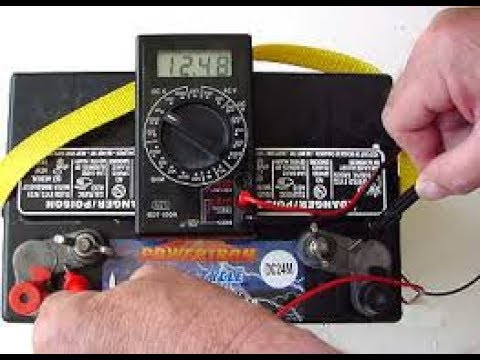To test a lawn mower battery, use a multimeter to check the voltage. A fully charged battery should read around 12.6 volts or higher.
Maintaining a healthy lawn mower battery is crucial for optimal performance. A weak or dead battery can lead to frustrating starts and reduced efficiency. Regular testing ensures your battery functions well, avoiding unexpected breakdowns during mowing season. Knowing how to assess your battery’s health helps you address issues early.
This process is simple and requires minimal tools. By following a few straightforward steps, you can prolong your battery life and keep your mower in peak condition. Read on to learn how to effectively test your lawn mower battery and ensure it’s always ready for action.

Credit: west-equip.com
How to Test Lawn Mower Battery : Step by Step Guide
Introduction To Lawn Mower Battery Testing
Testing your lawn mower battery is important for proper maintenance. A healthy battery ensures your mower starts easily. Regular checks can prevent unexpected failures.
There are different types of lawn mower batteries. The most common types include:
| Battery Type | Description |
|---|---|
| Lead-Acid | Durable and widely used. Good for gas mowers. |
| AGM | Absorbent Glass Mat. Offers higher performance and safety. |
| Lithium-Ion | Lightweight and fast charging. Ideal for electric mowers. |

Credit: www.jycbattery.com
Safety First: Preparing For The Test
Always wear safety gear before testing your lawn mower battery. This includes gloves, safety goggles, and a mask. These items protect against acid spills and other hazards.
Choose a well-ventilated area for testing. Proper airflow helps avoid harmful fumes. Make sure to keep any flammable materials away from the workspace.
Use a non-conductive surface to prevent electric shocks. Ensure that all tools are dry before starting. Keep children and pets away during the test.
Tools Needed For Battery Testing
To test a lawn mower battery, the right tools are essential. A multimeter is the most important tool. It helps measure voltage and check battery health. Choose a digital multimeter for easy reading and accuracy.
Other essential tools include:
- Wrench: For removing the battery terminals.
- Protective gloves: To keep hands safe during testing.
- Safety goggles: To protect eyes from possible sparks.
- Cleaning brush: To remove corrosion from terminals.
Having these tools ready makes battery testing simple and effective.
Visual Inspection Of The Battery
Start with a visual inspection of the battery. Look for any physical damage. Cracks or dents can indicate problems. Check the battery casing carefully. Ensure there are no leaks or bulges. These issues can cause the battery to fail.
Next, check for corrosion. This often appears as a white or green powder. Corrosion can block connections and reduce power. Use a wire brush to gently clean any corrosion. A solution of baking soda and water can help neutralize it. Rinse with clean water afterward.
Always wear gloves and safety goggles during this process. Keeping your battery clean ensures better performance and longevity.
Voltage Testing: The First Step
To test your lawn mower battery, use a multimeter. This tool measures voltage accurately. Start by setting the multimeter to the DC voltage setting. Then, connect the red probe to the positive terminal. Connect the black probe to the negative terminal.
Check the reading on the multimeter display. A healthy battery should show a voltage of at least 12.6 volts. If the reading is below 12.4 volts, the battery may need charging. Readings below 12 volts indicate a defective battery.
Regular testing helps keep your lawn mower running well. It ensures the battery is ready for use. Always handle the multimeter and battery with care.

Credit: m.youtube.com
Conducting A Load Test
To conduct a load test on your lawn mower battery, follow these simple steps. First, gather a multimeter and a load tester. Ensure the battery is fully charged before starting the test.
Connect the multimeter to the battery terminals. Set it to the DC voltage setting. A healthy battery should read around 12.6 volts or higher.
Next, attach the load tester to the battery. Apply a load equal to half of the battery’s cold cranking amps (CCA) rating. Keep the load for about 15 seconds while monitoring the voltage.
After the load test, check the voltage reading. A reading above 10.5 volts indicates a good battery. If it drops below this level, the battery may need replacement.
Hydrometer Testing For Lead-acid Batteries
Testing a lawn mower battery with a hydrometer is easy. This tool measures specific gravity in lead-acid batteries. Specific gravity helps determine the battery’s state of charge.
To test the battery, follow these steps:
- Remove the battery from the mower.
- Clean the battery terminals.
- Take the hydrometer and insert it into the battery cell.
- Squeeze the bulb to draw battery fluid into the hydrometer.
- Read the specific gravity on the scale.
- Repeat this for each cell in the battery.
A reading of 1.265 or higher means the battery is fully charged. A reading below 1.200 indicates it may need charging.
Maintenance Tips For Lawn Mower Batteries
Keep your lawn mower battery in top shape with regular cleaning. Remove dirt and debris from the battery surface. Use a damp cloth to wipe it down. This simple task helps prevent corrosion and extends battery life.
Check the battery terminals for any signs of rust. Clean them with a wire brush if needed. Ensure connections are tight to avoid power loss.
Charge your battery when you notice it struggling to start. A fully charged battery lasts longer and works better. Replace the battery every 3 to 5 years or if it fails to hold a charge. Regular maintenance ensures your mower runs smoothly.
Troubleshooting Common Battery Issues
Charging problems can happen for many reasons. Check the charger first. Make sure it is plugged in. Look for any damaged wires or connectors. If the charger works, inspect the battery terminals. Clean any dirt or corrosion from them.
Battery drain is another common issue. It may happen if the mower is not used regularly. Make sure to disconnect the battery if the mower sits for a long time. Store the battery in a cool, dry place to help it last longer. Always check the battery’s age. Old batteries may need replacement.
Conclusion: Ensuring Longevity And Performance
Regular testing of your lawn mower battery is very important. This helps to ensure optimal performance. A well-maintained battery lasts longer and works better.
Here are some key points to remember:
- Check the battery’s voltage regularly.
- Look for any corrosion on the terminals.
- Ensure connections are tight and secure.
- Keep the battery clean and free from dirt.
- Test the battery before the mowing season starts.
By following these tips, you can ensure your lawn mower battery stays in great shape.
Frequently Asked Questions
How Do I Know If My Lawn Mower Battery Is Dead?
To determine if your lawn mower battery is dead, check for signs like slow cranking or no power. You can also use a multimeter to measure the battery voltage. A reading below 12. 4 volts typically indicates a weak or dead battery.
Recharging or replacing it may be necessary.
What Tools Do I Need To Test A Lawn Mower Battery?
To test a lawn mower battery, you’ll need a multimeter, a wrench or socket set, and safety gloves. The multimeter helps measure voltage accurately. Wrenches are used for connecting or disconnecting battery cables. Always wear gloves to protect your hands from potential acid leaks or short circuits.
How Can I Recharge My Lawn Mower Battery?
To recharge your lawn mower battery, use a compatible battery charger. Connect the charger’s positive lead to the battery’s positive terminal, and the negative lead to the negative terminal. Set the charger to the appropriate voltage and amperage. Monitor the charging process and disconnect when fully charged to avoid overcharging.
How Long Does A Lawn Mower Battery Last?
A lawn mower battery typically lasts 3 to 5 years with proper care. Factors like usage, maintenance, and storage conditions influence its lifespan. Regularly checking the battery’s charge and cleaning terminals can extend its life. Always replace it when you notice significant performance issues or swelling.
Conclusion
Testing your lawn mower battery is essential for optimal performance. Regular checks can prevent unexpected breakdowns. Use a multimeter for accuracy and ensure connections are clean. By following these steps, you’ll extend your battery life and keep your mower running smoothly.
Regular maintenance leads to a healthier lawn and a happier you.

